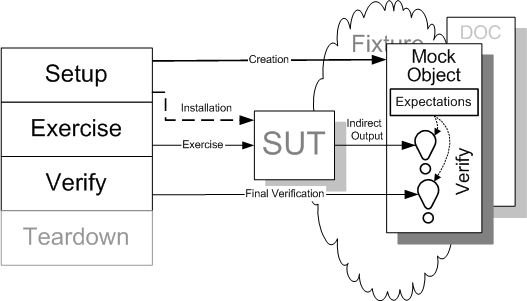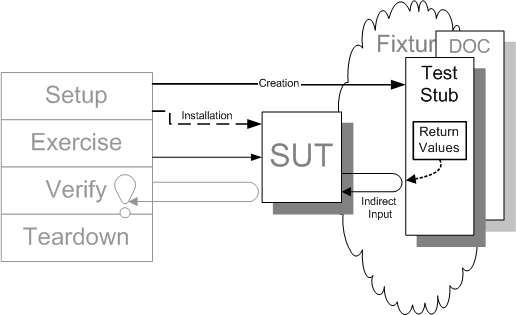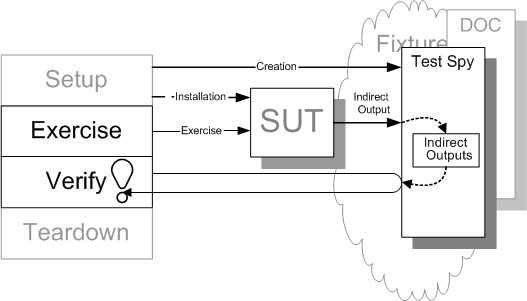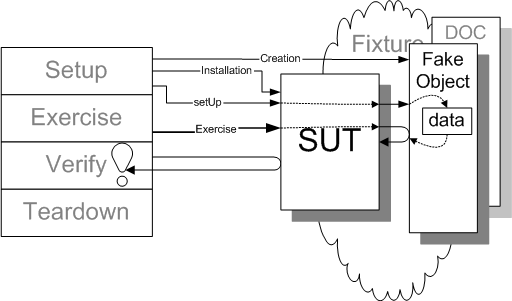여기저기서이상한소리만하는테스트대역(TestDouble)용어정리해보기
개요
Mock 프레임워크(ex: Mockito)를 사용하다보면 생소한 단어들이 자주 출몰하곤 합니다. @Spy, @Mock 등 뜻은 모른 체 기능만 이해하고 사용하는 경우가 많은데, 이에 대한 정확한 정의는 뭘까요?
최근 사내 스터디에서 읽고 있는 Unit Testing 또한 이러한 용어가 자주 언급됩니다. 토의를 진행하다가도 계속 물음표만 자아낼 뿐 맥락상으로만 이해한 것들이 많았는데, 이런 상태로 스터디를 이어가는 것도 한계가 있어보여 위 용어들을 명확하게 정의해보기로 하였습니다.
이번 포스트는 여러 자료를 토대로 모호한 Test Double Patterns 의 용어들을 잘 정의해보기 위해 작성했습니다. 간단한 예제를 통해 살펴보려고 하며, 저처럼 자료마다 제 각기인 Test Double 이야기에 신물이 난 분들에게 도움이 됐으면 좋겠습니다.
해당 포스트의 모든 내용은 xUnit Test Patterns 와 Martin Fowler 의 블로그 글을 기반으로 작성되었습니다.
기본적인 테스트 방법
우리는 기본적으로 테스트할 때, Given-When-Then(혹은 Arrange-Act-Assert) 구조를 따라갑니다. 주어진 상황에서 테스트 대상이 올바르게 동작하는지 검증하는 방식으로 구성되어 있죠.
public class OrderStateTester extends TestCase {
...
public void testOrderIsFilledIfEnoughInWarehouse() {
// Given
Order order = new Order(TALISKER, 50);
// When
order.fill(warehouse);
// Then
assertTrue(order.isFilled());
assertEquals(0, warehouse.getInventory(TALISKER));
}
...
}
그렇다면 검증한다는 것은 정확히 어떤 것을 검증하는 것일까요? 여기서 우리가 꼭 알아야 할 단어가 등장합니다. 바로, Behavior verification 과 State verification 입니다.
그 전에 잠시
앞선 두 검증 방식의 차이를 명확하게 이해하기 위해선 또 다시 Indirect Points 와 SUT(System Under Test) 를 의미를 이해해야 하는데요, 선행 과정이 많고 모두 추상적이라 걱정이지만, 간단하게 살펴봅시다.
System Under Test
The “system under test”. It is short for “whatever thing we are testing” and is always defined from the perspective of the test.
SUT(System Under Test) 는 실제 테스트할 대상(혹은 동작)을 지칭하는 포괄적인 개념입니다. 단위 테스트를 할 때 어떤 클래스, 오브젝트 혹은 메서드가 모두 포함될 수 있습니다.
Indirect Points
When the behavior of the system under test (SUT) includes actions that cannot be observed through the public API of the SUT but which are seen or experienced by other systems or application components, we call those actions the indirect outputs of the SUT.
Indircet Points 는 다른 어플리케이션이나 컴포넌트에서 일어나며, 실제 SUT 상에서 확인할 수 없는 동작들을 의미합니다. 예시로는 메세지 큐의 consume, 다른 컴포넌트의 메서드가 이에 해당할 수 있습니다.
이렇게만 설명하면 더욱 추상적이니 UserMailNotificationService 라는 시스템을 하나 가정해보도록 하겠습니다.
public UserMailNotificationService {
private MailService mailService;
private UserRepository userRepository;
public void sentAll(String msg) {
...
List<User> users = userRepository.findAll();
users.forEach(user -> {
boolean success = mailService.sent(user.getEmail(), msg);
if (success) {
user.setSent(Instant.now());
}
});
...
}
}
실제 UserMailNotificationService#sentAll 메서드 내부에서 mailService 를 이용해 어떤 메세지를 sent 하고 있지만 이는 내부 구현으로써, 외부에 공개되지 않은 동작입니다. 또한, mailService 는 실제로 UserMailNotificationService 에 대한 단위 테스트 시 우리가 집중해야할 대상이 아닙니다. 메일이 실제로 보내지는지 중요하지 않죠.
이러한 Indirect points 는 실제로 단위 테스트 시 처리하는 방법이 여러가지 존재합니다. Test Double 이 그 좋은 예이며, 계속해서 이들을 설명해보겠습니다.
Behavior verification vs State verification
State verification
이해하기 쉬운 State verification 부터 짚고 넘어가봅시다. State verification 은 실제 내부에 Indirect points 의 결과값이 어떻게 동작하든 상관없이, 동작 이후 SUT 의 상태만을 검증합니다.

앞서 들어본 예제를 이용하자면, UserMailNotificationService#sentAll 이후 유저의 상태 정도만 파악하겠죠.
public UserMailNotificationServiceTest {
...
@Test
void sentAll() {
String msg = "dummy";
User user = createUser();
userRepository.save(user);
service.sentAll(msg);
// state verification
assertThat(user.getSent()).isNotNull();
assertThat(user.getSent()).isLessThanEqaul(Instant.now());
...
}
...
}
Behavior verification
Behavior verification 은 이와 조금 다릅니다. SUT 가 실행되는 동안 실제 indrects points 또한 동작을 검증합니다.

앞서 본 예제를 조금 변형시킨다면, 아래와 같은 검증문을 통해 검사를 진행할 것입니다.
public UserMailNotificationServiceTest {
...
@Test
void sentAll() {
String msg = "dummy";
User user = createUser();
userRepository.save(user);
service.sentAll(msg);
// Behavior verification
Mockito.verify(**mockMailService**, times(1)).sent(user.getEmail(), msg);
...
}
...
}
Test Double Patterns 정리
Mock 을 이용한 테스트 방식

Mock Object 은 실제 indirect points 를 검증하는 도구입니다. 앞서 보았던 Behavior verification 을 사용하는 유일한 테스트 더블이며,방금 전 Mockito.verify(mockRepository, ..) 이 이에 해당합니다.
public UserMailNotificationServiceTest {
...
@Test
void sentAll() {
String msg = "dummy";
User user = createUser();
userRepository.save(user);
service.sentAll(msg);
// Behavior verification
Mockito.verify(**mockMailService**, times(1)).sent(user.getEmail(), msg);
...
}
...
}
Stub 을 이용한 테스트 방식

Test Stub 은 실제 SUT 상에서 indirect points 를 제어하고 미리 테스트에 필요한 결과값만을 제공합니다. State verification 을 사용하며, 예제는 아래와 같습니다.
public UserMailNotificationServiceTest {
...
@Test
void sentAll() {
String msg = "dummy";
User user = createUser();
userRepository.save(user);
List<User> users = List.of(user);
// stubbing
Mocktio.when(mailService.sent(User.class, String.class)).thenReturn(true); //stubbing
service.sentAll(msg);
// state verification
assertThat(sut).isEqualTo(users);
...
}
...
}
그 외
Test Spy

Test Spy 는 보통 Indirect points 와 실제로 같은 동작을 하며, 호출 횟수와 같은 추가적인 정보를 저장합니다. 아래는 이를 검증하는 예시입니다.
public UserMailNotificationServiceTest {
...
@Test
void sentAll() {
String msg = "dummy";
User user = createUser();
userRepository.save(user);
service.sentAll(msg);
// state verification
assertThat(**mailServiceSpy**.getNumberOfCalls()).isEqualTo(1);
...
}
...
}
Fake Object

Fake Object 는 실제로 동작하는 구현을 가지고는 있지만, 프로덕션 환경에서 적합하지 않은 구현체를 의미합니다. 가장 대표적인 예시로는 인메모리 데이터베이스가 있습니다.
맺음말
정리하고 든 생각입니다만, 이정도로까지 이해도를 깊게 가져갈 필요는 없어보입니다. 분명 Stubbing 과 Mocking 의 차이는 중요할 수 있지만, 라이브러리를 사용하는 입장에서는 모르고 사용해도 좋은 단위 테스트를 작성할 수 있으니까요.
이전에도 언급했지만 이론적인 부분과 실무는 항상 타협점이 존재한다 생각합니다. 이상적인 상황은 현실에선 드물기 때문이죠. Mockito 역시 Mocking Framework 가 아니고 실질적으론 Test Spy framework 입니다. 이런 사례에서도 볼 수 있듯이 명확한 정의는 중요한 것이 아니라고 느껴집니다.
각자가 생각하는 각 조직이 생각하는 테스트에 중요성이 있을 것이고, 서로간의 상호협의, 공유만 존재한다면 Mock 이 뭐고, Stub 이 뭔지 몰라도 충분히 상관없다 느낍니다. Test Double Patterns 는 아무리 생각해도 뇌절 같아요.
References
[1] https://martinfowler.com/articles/mocksArentStubs.html#TestIsolation [2] http://xunitpatterns.com/Test Double.html